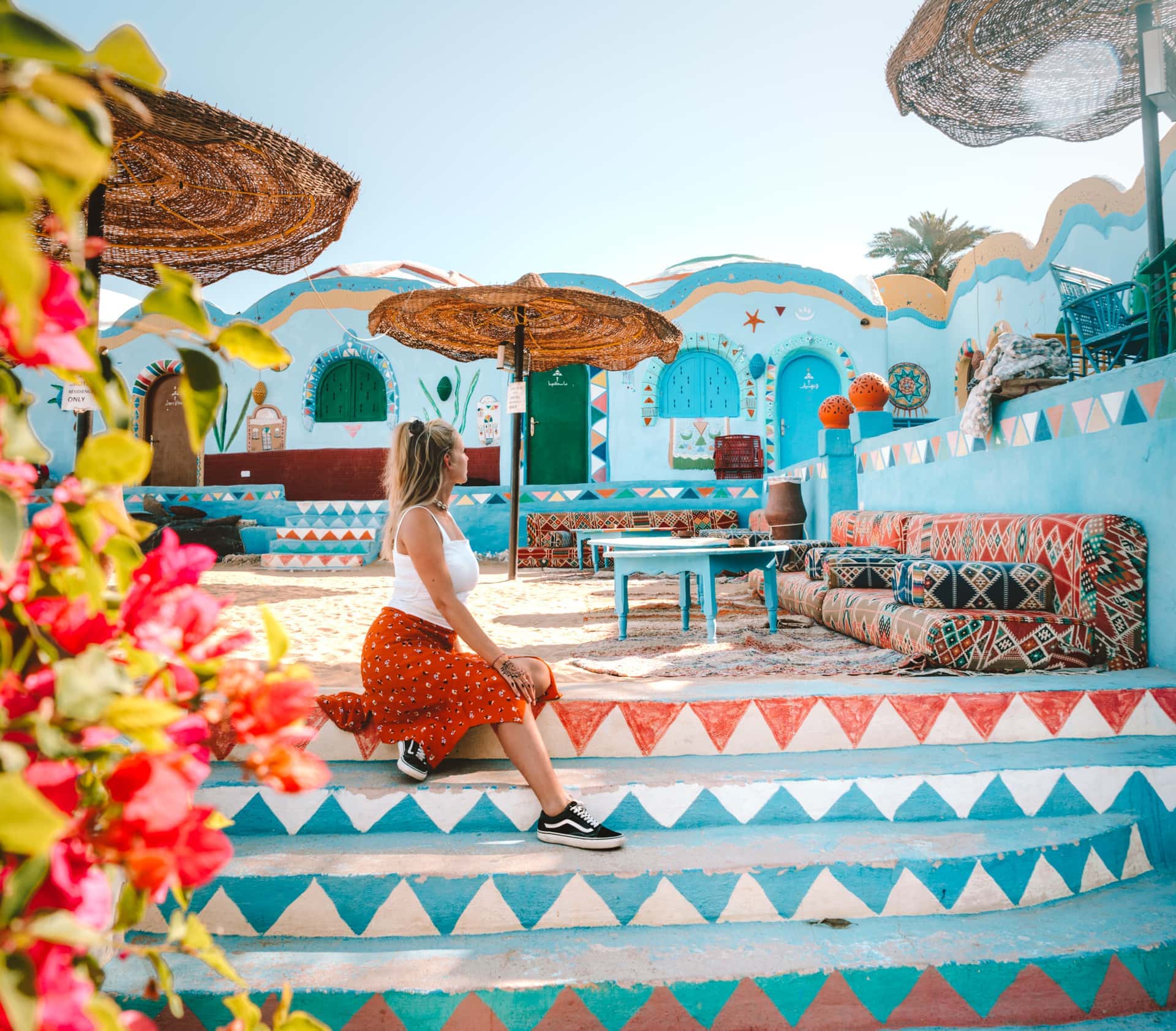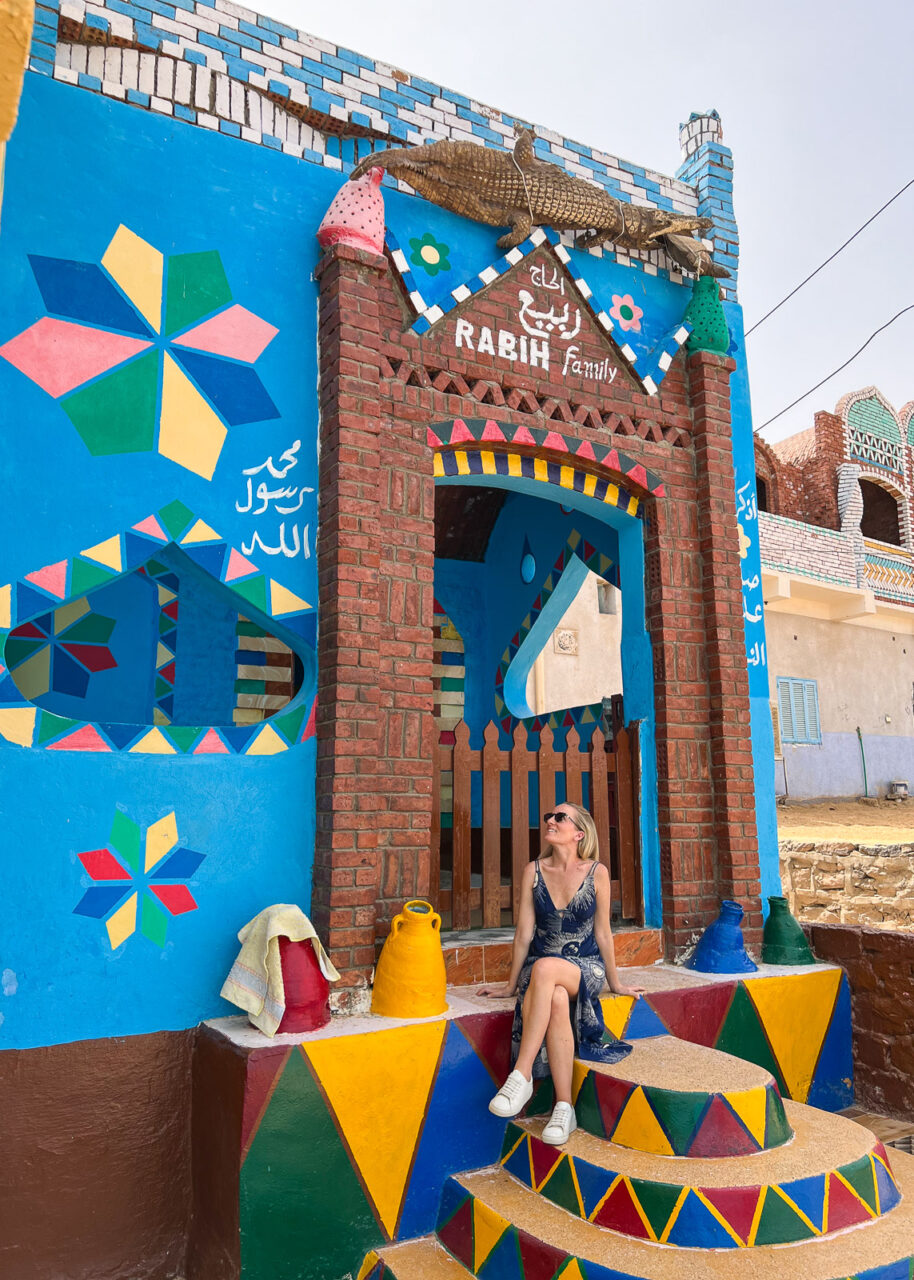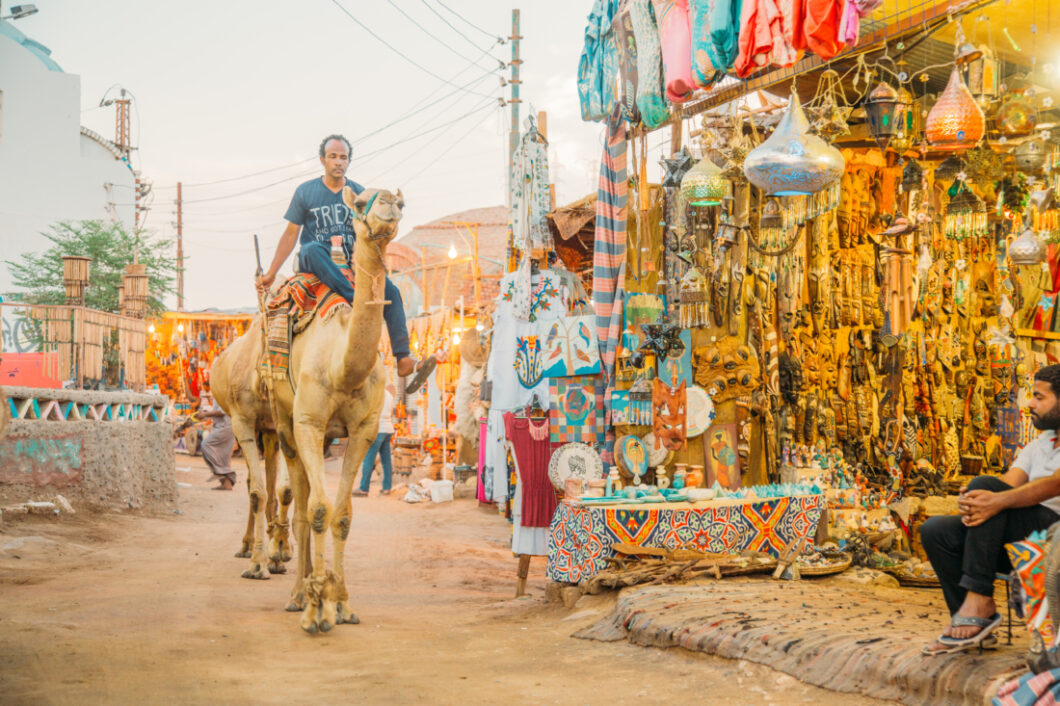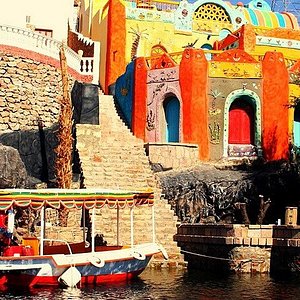A Nubian Village: A Step Back in Time
Welcome to a journey back in time to the enchanting world of the Nubian village.
Nestled on Elephantine Island in Aswan, Egypt, this colourful and vibrant community offers a glimpse into a rich and ancient culture. Explore the narrow streets adorned with brightly painted houses and captivating street art as you immerse yourself in the Nubian people's warm hospitality and unique traditions.
Join us as we uncover the secrets of this remarkable village and discover why a visit here is truly a step back in time.

Historical background of the Nubian people
The Nubian people are an ancient African civilisation with a rich cultural heritage. They are descendants of the ancient Egyptians and have a distinct language and culture that sets them apart. Nubia was located in what is now modern-day Sudan and southern Egypt. Throughout history, the Nubian people faced significant challenges and were often subjected to colonisation and forced displacement. Despite these hardships, they have preserved their unique language and traditions.
The Nubian villages in Egypt serve as living reminders of this rich history. Situated along the Nile River, these villages glimpse the Nubian way of life, with traditional houses painted in vibrant colours and intricate designs. The Nubian people are known for their warmth and hospitality, and visitors to the village can expect to be welcomed with open arms.
Exploring the Nubian village offers a chance to immerse oneself in the local culture. Visitors can sample traditional Nubian cuisine, which often includes Sudanese-style rice, stewed meats, and unleavened bread. Local delicacies such as date cookies and hibiscus tea are also popular among tourists.
In addition to the culinary delights, the Nubian village also offers a variety of sightseeing opportunities. Visitors can explore ancient temples, visit traditional Nubian handicraft shops, and enjoy traditional music and dance performances.
Efforts are being made to protect and conserve Nubian culture. Organisations and individuals are working together to document and preserve the Nubian language, customs, and traditions. Despite these efforts, the Nubian community still faces challenges such as cultural erosion and the encroachment of modernisation. It is crucial to continue supporting the preservation of the Nubian heritage to ensure that future generations can appreciate and learn from this ancient civilisation.
Significance of Nubian Villages in Egypt
The Nubian villages hold great significance in Egypt’s cultural landscape. They are a testament to the rich history and traditions of the Nubian people and serve as a reminder of the country’s diverse heritage. The Nubians have inhabited these villages for centuries, providing a glimpse into the ancient civilisation that once thrived in the region.
The Nubian villages have become an important tourist attraction, drawing visitors from all over the world eager to experience the unique culture and way of life. The warm and welcoming nature of the Nubian people is reflected in their hospitality, making tourists feel like part of the community during their stay. This connection enables visitors to understand Nubian traditions and customs better.
One of the most striking features of the Nubian villages is the architecture. The houses are typically built using locally sourced materials such as mud bricks, creating a distinctive, aesthetically pleasing and environmentally friendly look. Vibrant colours adorn the walls, adding to the visual appeal and creating a lively atmosphere.
Exploring the Nubian villages allows one to witness traditional music and dance performances. These performances are a reflection of the vibrant culture and deep-rooted traditions that have been passed down through generations. Visitors can immerse themselves in the rhythmic beats of the drums and the energetic dance moves, gaining a deeper appreciation for Nubian artistry.
Efforts to protect and conserve Nubian culture have been ongoing, recognising the importance of preserving this unique heritage. Various organisations and initiatives have been established to support the Nubian community and ensure their traditions and way of life are safeguarded for future generations. These efforts include the restoration of historical landmarks, promoting sustainable tourism, and empowering the Nubian people to preserve their cultural identity.
However, the Nubian community also faces challenges. Urban development and the construction of dams on the Nile River have caused displacement and loss of ancestral lands for many Nubians. Efforts to address these issues and protect the rights of the Nubian people continue, to find sustainable solutions that honour their cultural heritage.
Visiting a Nubian village is a step back in time and an opportunity to appreciate the rich tapestry of Egypt’s cultural diversity. It gives visitors a chance to learn from the Nubian people and gain a deeper understanding of their history, traditions, and the challenges they face. The significance of the Nubian villages extends beyond their physical presence, reminding them of the importance of preserving cultural heritage and promoting tolerance and inclusivity.

Visiting the Nubian Village
Location and accessibility of the Nubian Village
The Nubian Village is located in Aswan, Egypt, on the east bank of the Nile River. It is around 15 kilometres south of Aswan City, making it easily accessible for visitors interested in exploring Nubian culture and heritage.
To reach the Nubian Village, there are several transportation options available:
-
Boat: One of the most popular ways to reach the Nubian Village is by taking a boat ride along the Nile River. This scenic journey allows visitors to admire the beautiful landscape and enjoy the tranquillity of the river.
-
Taxi: Taxis are also available from Aswan City to the Nubian Village. The journey takes 15-20 minutes, depending on the traffic, and offers a convenient and comfortable way to reach the village.
-
Public Transportation: For budget-conscious travellers, public buses are available from Aswan City to the Nubian Village. These buses run regularly and offer an affordable option for reaching the village.
Once at the Nubian Village, visitors will be greeted with a warm and friendly atmosphere. The Nubian people are known for their hospitality and love for their culture. They are proud to share their traditions, language, and architecture with visitors, making it a memorable experience for anyone interested in immersing themselves in Nubian heritage.

Transportation options to reach the village
When visiting the Nubian Village, there are several transportation options available to reach the village:
-
Felucca: One of the most popular and traditional ways to travel to the Nubian Village is Felucca, a traditional Egyptian sailboat. Feluccas can be found along the Nile River, and tourists can hire one to take them from Aswan to the village. This journey allows travellers to enjoy the scenic views of the Nile River and experience the traditional mode of transportation used by the Nubian people.
-
Motorboats: For those who prefer a quicker and more convenient option, motorboats are available to transport tourists to the Nubian Village. These motorboats are faster than feluccas and provide a comfortable ride. They can be easily arranged through tour operators or directly at the Aswan waterfront.
-
Taxis and Private Cars: Taxis and private cars are also an option for reaching the Nubian Village. Visitors can hire a taxi or arrange a private car from Aswan to the village. This option provides flexibility and convenience, allowing travellers to explore the village at their own pace.
-
Organized Tours: Many tour operators in Aswan offer organized tours to the Nubian Village. These tours typically include transportation from Aswan to the village and guided tours and cultural experiences within the village. This option is ideal for those who prefer a hassle-free and well-organized trip.
No matter which transportation option visitors choose, reaching the Nubian Village is an opportunity to immerse oneself in the rich culture and history of the Nubian people.

Exploring the Nubian Culture
Unique language and traditions of the Nubian people
The Nubian people have a rich and vibrant culture characterized by their unique language and traditions. The Nubian language, known as Kenzi-Dongolawi, is part of the Nilo-Saharan language family and is spoken by the Nubian community. It is distinct from the Arabic language spoken in Egypt and has its grammar, vocabulary, and pronunciation.
The Nubian people also have a strong oral tradition, with storytelling and poetry playing a significant role in their culture. These oral traditions are passed down from generation to generation and reflect the history and values of the Nubian community.
Traditions such as henna tattoos, vibrant clothing, and intricate beadwork are central to the Nubian culture. Nubian weddings are particularly colourful and festive, with traditional dances and music performances that showcase the community's rich heritage.
Nubian traditions are deeply rooted in their close-knit community and their reverence for nature. They have a strong connection to the Nile River, which is central to their livelihoods and plays a significant role in their cultural practices and traditions.
Here are some key aspects of Nubian traditions:
-
Use of natural materials: Nubian crafts often incorporate natural materials such as palm leaves, reeds, and clay.
-
Traditional ceremonies and celebrations: The Nubian people celebrate various festivals throughout the year, including the Nubian New Year (Wafd), which marks the end of the Nile flood and the beginning of the agricultural season.
-
Respect for ancestors: Nubians deeply respect their ancestors and believe in maintaining a strong connection with them. Ancestral celebrations and rituals are an important part of Nubian culture.
-
Close-knit community: Nubian villages are known for their strong sense of community and unity. Families and neighbours support each other and often come together for communal activities and events.
-
Traditional medicine: The Nubian people have unique traditional medicine practices, which often involve using herbs and natural remedies.
Through their language and traditions, the Nubian people have managed to preserve their unique cultural identity and pass it down from one generation to the next. Their rich heritage and warm hospitality visit a Nubian village a truly unforgettable experience.

Traditional Nubian architecture and vibrant colours
The Traditional Nubian architecture is a distinct and vibrant feature of the Nubian village. The houses in the village are typically made of mud-brick or stone, with flat roofs that are often used as outdoor living spaces. The walls of the houses are adorned with intricate geometric patterns and colourful paintings, creating a visually striking and unique atmosphere. The vibrant colours in the decorations reflect the Nubian culture, known for its love of bright and bold hues.
One notable aspect of Nubian architecture is the emphasis on functionality and climate adaptability. The thick mud-brick walls provide excellent insulation, keeping the interiors cool in the scorching desert heat. The windows are typically small and high on the walls to minimize heat gain while allowing natural light to enter the rooms. The flat roofs are also designed to collect rainwater, which is stored in cisterns for future use.
The vibrant colours used in the Nubian architecture have cultural significance as well. They are believed to ward off evil spirits and bring good luck to the inhabitants. Each colour has a specific meaning: blue symbolizes the Nile River, green represents fertility and prosperity, yellow represents the desert and sunlight, and red symbolizes strength and courage.
Visitors to the Nubian village will be captivated by the unique architecture and vibrant colours that adorn the houses. It is a visual feast that provides a glimpse into the rich cultural heritage of the Nubian people.

Experiencing Nubian Hospitality
Interacting with the friendly Nubian locals
Interacting with the friendly Nubian locals is an experience that truly enriches visiting the Nubian Village. The Nubian people are known for their warm hospitality and welcoming nature, making visitors feel right at home. Whether enjoying a cup of tea together, engaging in friendly conversations, or participating in traditional activities, the locals go out of their way to make visitors feel like part of their community.
The Nubian people have a rich cultural heritage and are proud to share their traditions with visitors. They are always eager to teach visitors about their unique language, which is a blend of various Nubian dialects and has distinct vocabulary and pronunciation. Engaging in basic conversations or learning a few Nubian phrases can create instant connections and deepen cultural exchange.
Visitors to the Nubian Village also have the opportunity to witness traditional Nubian customs and practices. The locals often showcase their vibrant traditional clothing, jewellery, and accessories deeply rooted in their history and identity. Additionally, visitors may be invited to participate in traditional dances, drumming sessions, or other cultural performances, allowing them to fully immerse themselves in the Nubian culture and create lasting memories.
Moreover, the Nubian people are known for their culinary skills, and sampling the local cuisine is a must-do. Their dishes are a reflection of the region's agricultural heritage and the abundance of fresh ingredients. From savoury stews to mouthwatering desserts, Nubian cuisine offers a delightful culinary experience that can be enjoyed by the locals, who are often eager to share their traditional recipes and cooking techniques.
Interacting with the friendly Nubian locals offers a chance to learn about their culture and traditions and fosters a sense of unity and understanding between different communities. It is a testament to the resilience and cultural richness of the Nubian people, who have managed to preserve their heritage despite their challenges over the years.

Nubian cuisine and local delicacies
When visiting a Nubian village, one cannot miss out on experiencing the rich and flavoursome cuisine of the Nubian people. Nubian cuisine is a true reflection of their culture and heritage, with delicious and unique dishes. Here are some of the local delicacies you should try:
-
Ful Medames: A traditional Egyptian dish made from fava beans simmered and seasoned with spices such as garlic, lemon juice, and olive oil. It is commonly eaten for breakfast and is packed with protein and nutrients.
-
Hamam Mahshi: This dish features stuffed pigeons, a speciality in Nubian cuisine. The pigeon is typically stuffed with rice, herbs, and spices and then roasted or cooked in a clay oven. It is a delicacy reserved for special occasions.
-
Meshabek: This is a sweet treat made from flour, sugar, ghee, and sesame seeds. It is formed into a thin, crispy layer and then rolled into a cone shape. It is often enjoyed with tea or as a snack.
-
Arwi: Arwi is a wild edible green that grows abundantly along the Nile. It is usually cooked with garlic, onions, and spices and served as a side dish or added to stews and soups.
-
Shai Naimi: This is a popular Nubian tea made with black tea leaves, infused with fresh mint leaves, and sweetened with sugar or honey. It is a refreshing and aromatic beverage often served in small glasses.
Exploring Nubian cuisine is a delight for the taste buds and a way to immerse oneself in the local culture and traditions. Be sure to try these delicacies and discover the unique flavours of Nubian cuisine.

Activities in the Nubian Village
Sightseeing and landmarks in the village
One of the highlights of visiting a Nubian village is exploring the various sightseeing spots and landmarks that showcase the rich cultural heritage of the Nubian people. Here are some must-visit attractions in the village:
-
Nubian Houses: The traditional Nubian houses are distinct for their vibrant colours and unique architecture. These houses are typically painted with bright shades of blue, yellow, and green, creating a picturesque and eye-catching sight.
-
Nubian Museum: Located in Aswan, the Nubian Museum is dedicated to preserving and showcasing the art, history, and culture of the Nubian people. The museum houses many artefacts, including pottery, jewellery, and ancient manuscripts.
-
Nubian Temples: The Nubian villages are also home to several ancient temples with historical and archaeological significance. The Kiosk of Qertassi, located on Elephantine Island, is a well-preserved temple that offers a glimpse into the religious practices of the Nubian civilization.
-
Nile River: The villages are situated along the banks of the Nile River, providing breathtaking views of the river and its surrounding landscapes. Taking a boat ride or a felucca trip along the Nile is a popular activity among visitors, allowing them to admire the area's natural beauty.
-
Traditional Markets: The Nubian villages are known for their vibrant markets, where visitors can explore and purchase handmade crafts, colourful textiles, and traditional Nubian souvenirs. These markets offer a unique shopping experience and a chance to support local artisans.
Visiting these sightseeing spots and landmarks in a Nubian village provides an immersive experience of the history, culture, and traditions of the Nubian people, making it a truly memorable journey.

Traditional music and dance performances
Traditional music and dance performances play a significant role in Nubian culture and are a must-see when visiting a Nubian village. These performances are entertaining and offer a glimpse into the rich history and traditions of the Nubian people.
Nubian music is known for its lively rhythms and melodic tunes, often accompanied by the mesmerizing sounds of the oud, a traditional string instrument. The songs are typically sung in the Nubian language and convey stories of love, nature, and daily life. The music is infectious, and it's common to see locals and visitors alike dancing and clapping to the beat.
Nubian dance forms are energetic and vibrant, with expressive movements that reflect the joy and celebration of the community. The dancers often wear brightly coloured traditional clothing, adding to the visual spectacle. The dances are accompanied by rhythmic hand clapping and foot stomping, creating an immersive and interactive experience for the audience.
Visitors to the Nubian village can witness these captivating performances during cultural events or special occasions. It's a chance to immerse oneself in the rhythms and melodies of Nubian music and be enchanted by the skill and passion of the dancers.
Key highlights of Nubian music and dance performances:
- Lively rhythms and melodic tunes
- Accompanied by the oud, a traditional string instrument
- Sung in the Nubian language
- Reflect stories of love, nature, and daily life
- Energetic and vibrant dance forms
- Expressive movements and rhythmic clapping
- Colourful traditional clothing adds to the visual spectacle
Experiencing traditional music and dance performances in a Nubian village is a memorable and culturally immersive experience that shouldn't be missed.

Preserving the Nubian Heritage
Efforts to protect and conserve Nubian culture
Efforts to protect and conserve Nubian culture have been ongoing for several decades. The Nubian people have a rich cultural heritage rooted in their ancient history and traditions. Recognizing the importance of preserving this heritage, various organizations and individuals have actively participated in initiatives to safeguard Nubian culture. Some of these efforts include:
-
Nubian Heritage Museum: Establishing museums dedicated to Nubian culture and history has been crucial in preserving and promoting Nubian traditions. These museums showcase artefacts, artworks, and historical documents that provide insights into Nubian life and traditions.
-
Cultural Festivals and Events: Regular festivals and events are organized in Nubian villages to celebrate and showcase Nubian music, dance, cuisine, and crafts. These events provide a platform for the Nubian community to share their cultural practices, attract visitors, and raise awareness about Nubian culture.
-
Documentation and Research: Scholars and researchers have conducted studies documenting the Nubian language, traditions, and customs. This research helps understand Nubian culture comprehensively and contributes to its preservation.
-
Architectural Conservation: The unique architecture of Nubian villages, characterized by vibrant colours and intricate designs, is an integral part of Nubian culture. Efforts have been made to preserve and restore Nubian houses and buildings, ensuring that future generations can experience the beauty of this architectural style.
-
Community Initiatives: Local Nubian communities play a vital role in preserving their culture. Through oral traditions and mentoring programs, they actively pass on their traditional knowledge and skills to younger generations. By maintaining their language, traditions, and customs, the Nubian community ensures the continuity of their cultural heritage.
Preserving and conserving Nubian culture is crucial to keeping alive the rich traditions and history of the Nubian people. It requires a combination of individual, community, and organisation efforts to ensure that future generations can continue to appreciate and learn from this unique culture.

Challenges faced by the Nubian community
Despite their rich cultural heritage, the Nubian community faces various challenges in preserving their traditions and way of life. One significant challenge is the displacement of Nubian villages due to the construction of the Aswan High Dam in the 1960s. This forced the relocation of numerous Nubian families, disrupting their tight-knit communities and causing a loss of ancestral land and homes. The Nubians had to adapt to new living conditions and navigate the challenges of assimilating into urban settings.
Another challenge is the dilution of the Nubian language and culture. With increased urbanization and modernization, younger generations are more inclined to adopt the dominant Egyptian Arabic, leading to a decline in the usage and preservation of the Nubian language. Efforts are being made to revitalize the language through education and cultural programs, but the threat of further language erosion remains.
The Nubian community also faces economic challenges, with limited employment opportunities and a reliance on tourism for income. The lack of sustainable livelihoods often forces young Nubians to leave their villages for better opportunities in urban areas, leading to a loss of cultural continuity.
Lastly, preserving Nubian cultural heritage is an ongoing challenge. The Nubian people have a rich oral tradition, but with the passing of older generations, there is a risk of losing valuable traditional knowledge and practices. Efforts are being made to document and record Nubian folklore, music, and dance to ensure their preservation for future generations.
Addressing these challenges requires a multi-faceted approach that includes community empowerment, sustainable economic development, and cultural preservation initiatives. By valuing and supporting the Nubian community, we can help ensure the continuation of their vibrant culture and unique way of life.
